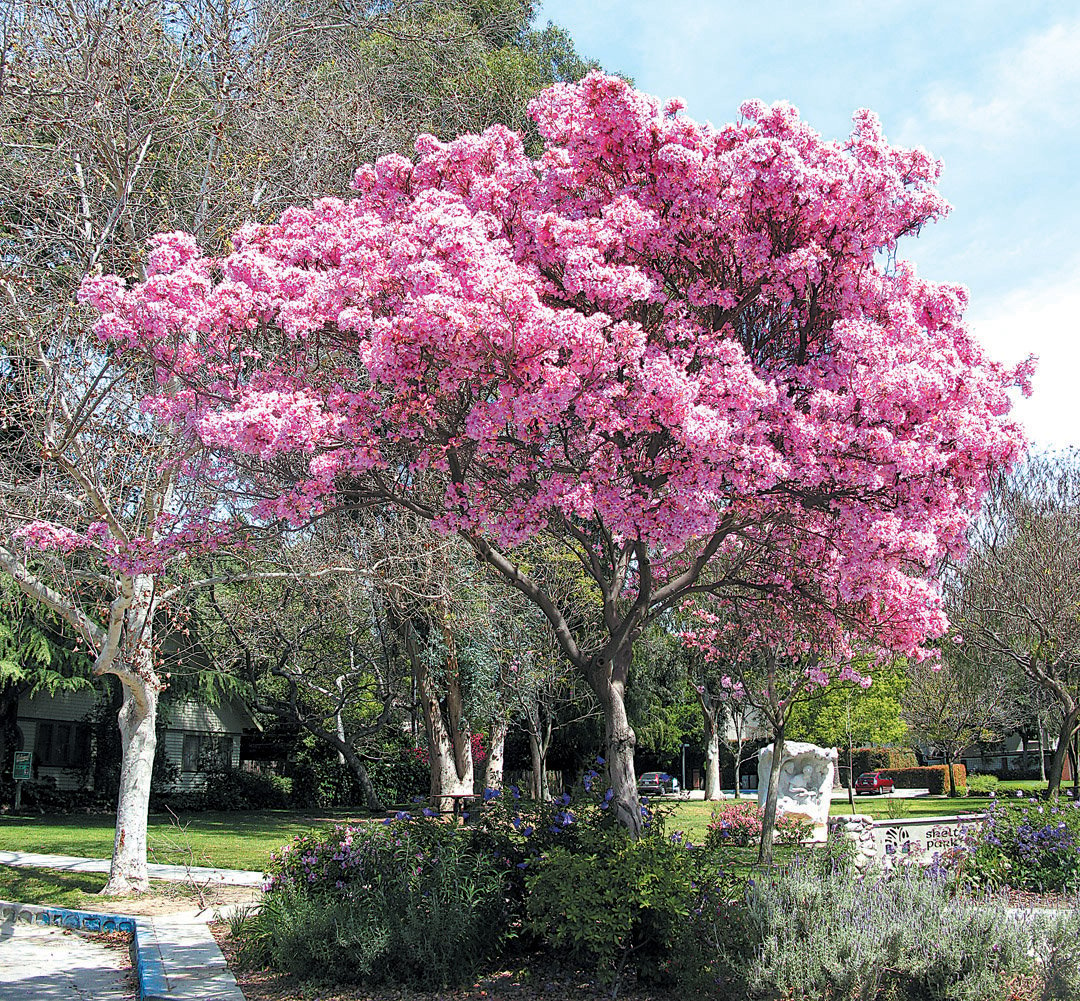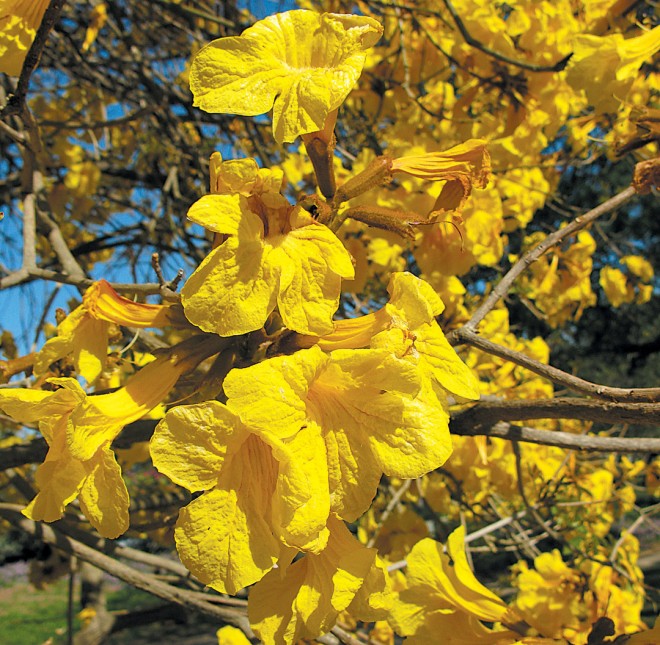
Striving for Diversity: The Trumpet Trees

Contributor

Few spring-blooming trees are more spectacular than the trumpet trees. In March and April, they enliven Southern California neighborhoods with a short-lived, yet dazzling display of gold or pink flowers. A leafless tree adorned with tens of thousands of large, almost unnaturally bright, trumpet-shaped flowers is a sight to behold. After an early spring stroll through Arcadia’s Los Angeles County Arboretum or Santa Barbara’s Alice Keck Park Garden, one is left wondering why such trees are not more widely planted. These lovely tropical trees are the subjects of the first installment of articles in Pacific Horticulture on undeservedly rare trees.
The Los Angeles County Arboretum & Botanic Garden, which has the best collection of mature trumpet trees in California, helped to introduce them to cultivation in the 1970s. Although primarily grown in Southern California (Sunset zones 15, 16, 20-24), these small to medium-sized charmers could be cultivated in more northerly locations, as they are cold hardy to temperatures as low as 20° F. The trumpet trees at The Ruth Bancroft Garden in Walnut Creek (Sunset zone 15), thirty miles inland from San Francisco, bloom bountifully each spring, having survived a number of relatively significant freezes on their way to maturity.
A Showy Family
Trumpet trees are members of the tropical Bignonia family (Bignoniaceae), which contains some of the showiest trees in the world, including jacaranda (Jacaranda mimosifolia), African tulip tree (Spathodea campanulata), sausage tree (Kigelia africana), and catalpas (Catalpa spp.). Two species of trumpet tree are commonly grown in California: pink trumpet tree (Handroanthus impetiginosus), with light pink to magenta purple flowers (often with a yellow throat), and golden trumpet tree (Handroanthus chrysotrichus), with maroon-striped, golden yellow flowers. Both are native to Central and South America; like many trees in seasonally dry, subtropical and tropical habitats, they lose their leaves during the dry season and flower in a leafless state before the rains return. In California, trumpet trees usually drop their leaves in late winter, bloom gloriously in March and April, then push out new leaves as their flowers wane.


About thirty species of trees previously placed in the genus Tabebuia, including both trumpet trees, were renamed Handroanthus in 2007, upon discovery that they were more closely related to genera other than Tabebuia. Pink trumpet tree, for instance, is more closely related to the calabash tree (Crescentia cujete) than it is to other species of Tabebuia, such as rosy trumpet tree (T. rosea). Subsequently, our common trumpet trees, Tabebuia chrysotricha and T. impetiginosa, became Handroanthus chrysotrichus and H. impetiginosus. Although these name changes represent a necessary progression of our understanding of the evolutionary relationships among these trees, they result in the unfortunate loss of a name that has always been fun to say—ta-beh-BOO-yah. The genus Handroanthus was first used by Brazilian botanist João Mattos in 1970 to commemorate another Brazilian botanist, Oswald Handro, who had previously named a number of plants after Mattos (a botanical mutual appreciation society).

Distinctive Leaves
These two trumpet trees have hard, fissured bark and palmately compound leaves that are borne in pairs. Trees with this kind of leaf shape and attachment are unusual: only one of California’s 5,000 or so native plants—California buckeye (Aesculus californica)—has this arrangement. The leaves of both trumpet trees consist of five to seven dark green leaflets, which are hairless in pink trumpet trees and covered with rusty hairs on golden trumpet trees.

Golden trumpet tree is slower growing and less cold hardy than its pink-flowered relative. It is also smaller and more uniform in shape and flower color. Pink trumpet tree is quite variable in blooming season, leaf shape, age to first bloom (three to twenty years from seed), mature tree size, and flower color. This variability in cultivation may be due to multiple introductions from different parts of its extensive native range (from Mexico to Argentina). There has always been confusion and disagreement about which trees are actually Handroanthus impetiginosus; consequently, several cultivars, subspecies, at least ten synonymous scientific names, and over thirty common names are applied to this one species. Pink trumpet tree is also one of the numerous species whose wood is sold in the United States under the name ipe (pronounced ee-pay)—a honey-colored, remarkably durable hardwood used for outdoor decking.
Photographs do not do these trees justice. They are best experienced firsthand, preferably on a bright, sunny, early spring day. Asking for them at your local nursery or finding streets, parks, and gardens where they are growing is well worth the effort. If you catch one in full bloom, you are sure to be entranced.
Share:
Social Media
Garden Futurist Podcast
Most Popular
Videos
Topics
Related Posts

Ground Up Science for Greener Cities with Garden Futurist Dr. Alessandro Ossola
Spring 2023 Listen to the Podcast here. Alessandro Ossola is a scientist who gets very excited about the challenge of climate change allowing for an

Readying Urban Forests for Climate Realities with Garden Futurist Dr. Greg McPherson
Winter 2023 Listen to the Podcast here. “Going from the mow and blow to a more horticulturally knowledgeable approach to maintaining the landscape. And that

Welcome, Greywater, to the Garden
Summer 2022 Oh, summer: delightful warm air, tomatoes swelling on the vine, fragrant blooms on an evening stroll. When it’s warm and rainless, how is

Big Tree-Data and Big-Tree Data with Garden Futurist Matt Ritter
Summer 2022 Listen to the full Garden Futurist: Episode XV podcast here. We are in an environmental crisis right now in many parts of California











Responses